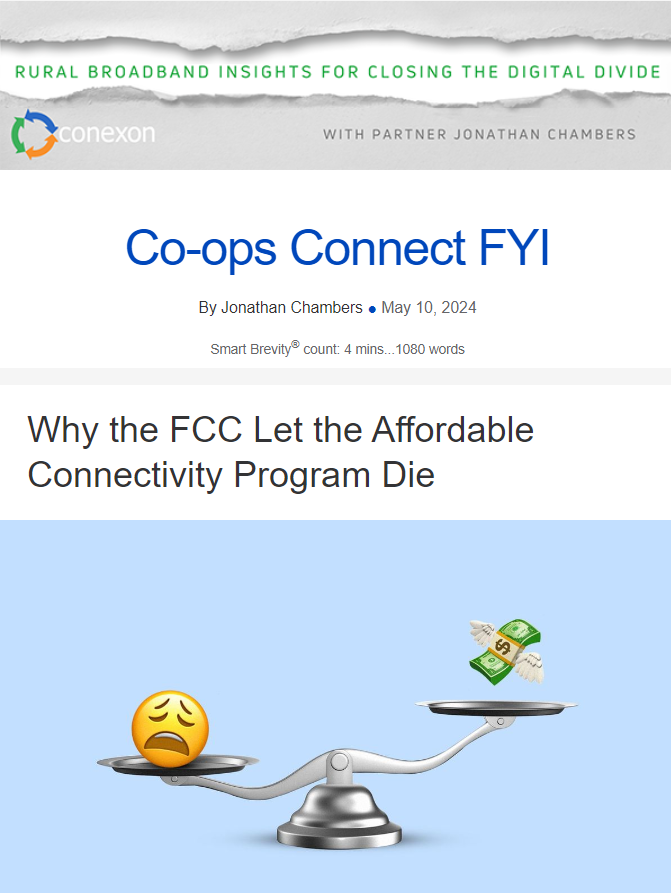Why the FCC Let the Affordable Connectivity Program Die
May 10, 2024
The Affordable Connectivity Program (ACP) is shutting down. Over the past few months, the FCC stopped accepting new participants; then they cut the benefit by more than half; and now the program will shutter its doors at the end of the month.
- Even if Congress passes an emergency ACP funding bill, the new funding as configured would merely kick the can down the road until the end of the year.
The past six months, the FCC has had essentially three options:
1. Fully fund ACP through the FCC’s Universal Service regulatory authority;
2. Reform ACP by reducing its size and combining it with one of its existing Universal Service programs; or
3. Look to Congress to approve additional funding.
A Primer on the FCC’s Financial Authority

To understand how the FCC could continue ACP on its own, here’s a brief primer on the FCC’s authority to collect and spend money.
Prior to the 1996 Telecommunications Act, the FCC and state commissions regulated the prices and services of telephone companies.
- State commissions regulated intrastate telephone traffic; the FCC regulated interstate and international telephone traffic.
- This scheme ensured that rates were affordable, particularly for residential service.
- In short: Monies from long-distance service subsidized local service; monies from business service subsidized residential service; and monies from urban service subsidized rural service.
The 1996 Telecommunications Act was designed to open the telecommunications markets to competition. To do that, the subsidy mechanisms were made explicit.
- Over the next 20 years, the FCC largely replaced the prior subsidy regime with a schedule of assessments and disbursements.
- All telecommunications carriers were required to make “contributions” to the Universal Service Fund, which disbursed funds to companies providing services to schools, libraries, rural areas, and low-income households.
The Universal Service Fund consists of four major areas:
1. The High-Cost Fund (for rural programs, including RDOF), which annually disburses more than $4 billion;
2. The E-rate Fund (for schools and libraries), which annually disburses nearly $5 billion;
3. The Lifeline Program (for low-income households), which annually disburses less than $1 billion; and
4. The Rural Health Care Program (for rural health provider connectivity), which annually disburses about $400 million.
The Universal Service Fund is funded by assessments on interstate and international telecommunications services.
- When the Universal Service Fund approach began, interstate and international telecommunications services revenue exceeded $100 billion.
- Today, the revenues for these services has shrunk to a little more than $30 billion.
The big picture:
To collect $10 billion annually from a $30 billion revenue base, the FCC currently assesses telecommunications companies nearly one-third of their revenues.
Since only Congress has the power to tax, it’s called a “contribution;” for the second quarter of 2024, the Contribution Factor is 32.8%.
The FCC’s Options for ACP

Now, back to the FCC’s three options for extending ACP.
ACP spending had grown to $1 billion each month before the FCC halted new subscribers. (Given the number of eligible households in the country, ACP could have grown to $1.5 billion or $2 billion per month.)
Adding ACP to the FCC’s Universal Service Fund programs would require the FCC to collect at least another $12 billion from its shrinking base of $30 billion. Though economists argue over the level of taxation considered confiscatory, I’m pretty certain a 67% Contribution Factor would be confiscatory.
Option 1:
Thus, the only way the FCC could add ACP to its current programs would be to expand the base of assessments. It had that opportunity just weeks ago.
- The FCC authority to assess revenues is limited to interstate and international telecommunications revenue. Up until a few weeks ago, broadband internet access was considered an information service and not subject to FCC assessment.
- But, in a proceeding to reinstitute Net Neutrality regulations, the FCC reclassified internet access as a telecommunications service, opening the option of assessments on revenues from fixed and mobile data services.
- Why it matters: The now $30 billion contribution base had (and has) the ability now to be hundreds of billions in annual revenue.
- The bottom line: The FCC chose not to extend the assessment to those revenues, thus foreclosing the first option.
Option 2:
The second option is the proposal to reform the ACP by restricting the $30 per family subsidy for residential broadband to those most in need – those making 135% of the poverty line or less (the longstanding eligibility criterion for FCC low-income programs).
- Why it matters: The FCC has sufficient budget for that reform; however, it chose not to consider the proposal I submitted to try to ensure it continued to help those most in need. (Read the proposal in the Feb. 9 Co-ops Connect FYI.)
- The bottom line: The FCC actively discouraged others from supporting this fully funded proposal.
Option 3:
The third option is the one the FCC has chosen: Let this Congress decide.
- Why it matters: This decision was a conscious choice by the FCC, not an inevitability.
- The bottom line: When Congress appropriated over $14 billion for ACP, legislators may have thought the funding would last longer than two years. The funding was intended to work together with BEAD, so I suspect Congress is surprised that ACP ran out of money before the BEAD rural program began.
The Final Word

I disagree with the FCC’s choice not to make the ACP sustainable under the FCC’s existing authority by combining it with Lifeline and setting a 5-year budget.
That said, I do understand FCC Chairwoman Rosenworcel’s decision.
- The ACP program was created by Congress. If Congress wants the program to continue, then Congress can appropriate more money.
- I recall when the idea of ACP was first floated, there was a view that the program needed to grow to gain widespread support.
- After all, the High-Cost programs have strong support from the telecommunications industry. The E-rate programs have support from the nation’s schools and libraries. But who lobbies for the poor?
- Thus, the proponents of the idea created a new name and expanded the pool of eligibility to the middle class. And then, policymakers encouraged companies to make ACP-subsidized services free.
- Subscriptions grew to over 20 million in just over a year, demonstrating that free money is popular.
The big picture:
Perhaps some thought ACP would become too big to fail. The best of intentions and all that.
RIP ACP.
